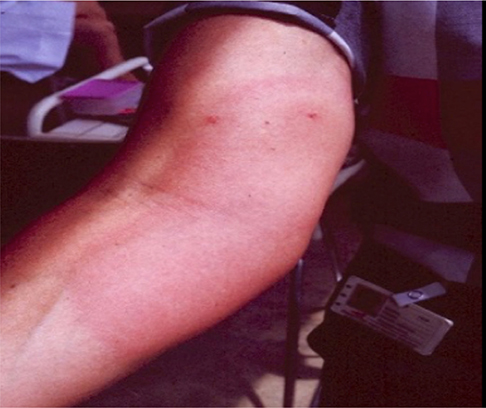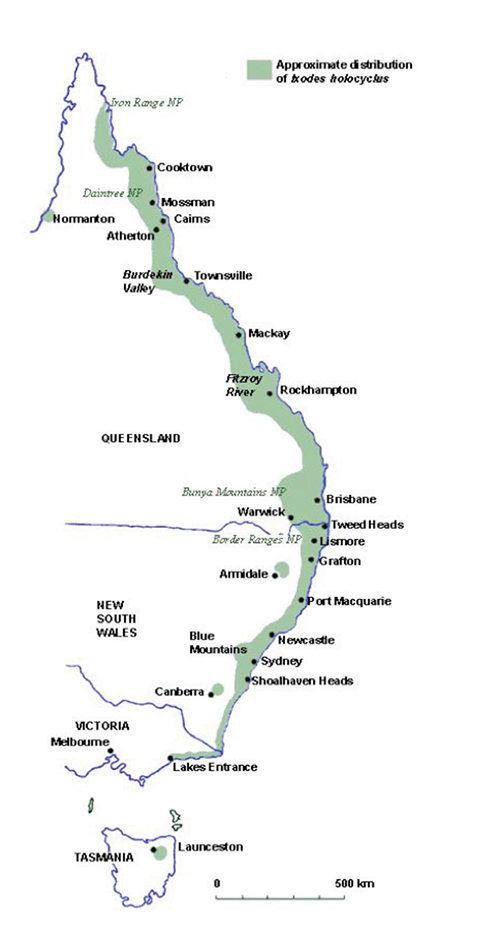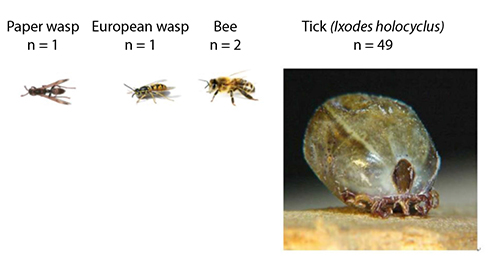Asia Pac Allergy.
2015 Jan;5(1):3-16. 10.5415/apallergy.2015.5.1.3.
Tick-induced allergies: mammalian meat allergy, tick anaphylaxis and their significance
- Affiliations
-
- 1Department of Clinical Immunology and Allergy, Royal North Shore Hospital and Sydney Medical School-Northern, St Leonards NSW 2065, Australia. vannunen@med.usyd.edu.au
- KMID: 2397062
- DOI: http://doi.org/10.5415/apallergy.2015.5.1.3
Abstract
- Serious tick-induced allergies comprise mammalian meat allergy following tick bites and tick anaphylaxis. Mammalian meat allergy is an emergent allergy, increasingly prevalent in tick-endemic areas of Australia and the United States, occurring worldwide where ticks are endemic. Sensitisation to galactose-α-1,3-galactose (α-Gal) has been shown to be the mechanism of allergic reaction in mammalian meat allergy following tick bite. Whilst other carbohydrate allergens have been identified, this allergen is unique amongst carbohydrate food allergens in provoking anaphylaxis. Treatment of mammalian meat anaphylaxis involves avoidance of mammalian meat and mammalian derived products in those who also react to gelatine and mammalian milks. Before initiating treatment with certain therapeutic agents (e.g., cetuximab, gelatine-containing substances), a careful assessment of the risk of anaphylaxis, including serological analysis for α-Gal specific-IgE, should be undertaken in any individual who works, lives, volunteers or recreates in a tick endemic area. Prevention of tick bites may ameliorate mammalian meat allergy. Tick anaphylaxis is rare in countries other than Australia. Tick anaphylaxis is secondarily preventable by prevention and appropriate management of tick bites. Analysis of tick removal techniques in tick anaphylaxis sufferers offers insights into primary prevention of both tick and mammalian meat anaphylaxis. Recognition of the association between mammalian meat allergy and tick bites has established a novel cause and effect relationship between an environmental exposure and subsequent development of a food allergy, directing us towards examining environmental exposures as provoking factors pivotal to the development of other food allergies and refocusing our attention upon causation of allergy in general.
Keyword
MeSH Terms
Figure
Cited by 3 articles
-
Asia Pacific allergy: four years of experience
Yoon-Seok Chang
Asia Pac Allergy. 2015;5(1):1-2. doi: 10.5415/apallergy.2015.5.1.1.Asia Pacific allergy: 6 years old
Yoon-Seok Chang
Asia Pac Allergy. 2017;7(1):1-2. doi: 10.5415/apallergy.2017.7.1.1.A novel Australian tick Ixodes (Endopalpiger) australiensis inducing mammalian meat allergy after tick bite
Mackenzie Kwak, Colin Somerville, Sheryl van Nunen
Asia Pac Allergy. 2018;8(3):. doi: 10.5415/apallergy.2018.8.e31.
Reference
-
1. Graft DF, Schuberth KC, Kagey-Sobotka A, Kwiterovich KA, Niv Y, Lichtenstein LM, Valentine MD. A prospective study of the natural history of large local reactions after Hymenoptera stings in children. J Pediatr. 1984; 104:664–668.
Article2. van Nunen SA, Fernando SL, Clarke LR, Boyle RX. The association between Ixodes holocyclus tick bite reactions and red meat allergy [abstract]. Intern Med J. 2007; 37:Suppl 5. A132.3. van Nunen SA, O'Connor KS, Clarke LR, Boyle RX, Fernando SL. An association between tick bite reactions and red meat allergy in humans. Med J Aust. 2009; 190:510–511.
Article4. O'Neil BH, Allen R, Spigel DR, Stinchcombe TE, Moore DT, Berlin JD, Goldberg RM. High incidence of cetuximab-related infusion reactions in Tennessee and North Carolina and the association with atopic history. J Clin Oncol. 2007; 25:3644–3648.5. Chung CH, Mirakhur B, Chan E, Le QT, Berlin J, Morse M, Murphy BA, Satinover SM, Hosen J, Mauro D, Slebos RJ, Zhou Q, Gold D, Hatley T, Hicklin DJ, Platts-Mills TA. Cetuximab-induced anaphylaxis and IgE specific for galactose-alpha-1,3-galactose. N Engl J Med. 2008; 358:1109–1117.6. Commins S, Lucas J, Hosen J, Satinover SM, Borish L, Platts-Mills TA. Anaphylaxis and IgE antibodies to galactose-alpha-1,3-galactose (alphaGal): insight from the identification of novel IgE ab to carbohydrates on mammalian proteins [abstract]. J Allergy Clin Immunol. 2008; 121:S25.7. Mullins RJ. Clinical significance of sensitisation to gelatine colloids in 800 patients [abstract]. J Allergy Clin Immunol. 2008; 121:S26.8. Commins SP, Satinover SM, Hosen J, Mozena J, Borish L, Lewis BD, Woodfolk JA, Platts-Mills TA. Delayed anaphylaxis, angioedema, or urticaria after consumption of red meat in patients with IgE antibodies specific for galactose-alpha-1,3-galactose. J Allergy Clin Immunol. 2009; 123:426–433.9. Commins SP, Platts-Mills TA. Tick bites and red meat allergy. Curr Opin Allergy Clin Immunol. 2013; 13:354–359.
Article10. Hamsten C, Tran TA, Starkhammar M, Brauner A, Commins SP, Platts-Mills TA, van Hage M. Red meat allergy in Sweden: association with tick sensitization and B-negative blood groups. J Allergy Clin Immunol. 2013; 132:1431–1434.
Article11. Wickner PG, Commins S. The first central american cases of delayed meat allergy with galactose-alpha-1,3-galactose positivity clustered among field biologists in panama [abstract #736]. In : 2014 AAAAI Annual Meeting; 2014 February 28-March 4; San Diego, CA, USA. Milwaukee, WI: American Academy of Allergy, Asthma & Immunology;2014.12. Mullins RJ, James H, Platts-Mills TA, Commins S. Relationship between red meat allergy and sensitization to gelatin and galactose-α-1,3-galactose. J Allergy Clin Immunol. 2012; 129:1334–1342.e1.
Article13. James HR, Commins SP, Kelly LA, Pochan SL, Workman LJ, Mullins RJ, Platts-Mills TA. Further evidence for tick bites as a cause of the IgE responses to alphagal that underlie a major increase in delayed anaphylaxis to meat [abstract]. J Allergy Clin Immunol. 2011; 127:2 Suppl. AB243.14. Kennedy JL, Stallings AP, Platts-Mills TA, Oliveira WM, Workman L, James HR, Tripathi A, Lane CJ, Matos L, Heymann PW, Commins SP. Galactose-α-1,3-galactose and delayed anaphylaxis, angioedema, and urticaria in children. Pediatrics. 2013; 131:e1545–e1552.
Article15. Pointreau Y, Commins SP, Calais G, Watier H, Platts-Mills TA. Fatal infusion reactions to cetuximab: role of immunoglobulin e-mediated anaphylaxis. J Clin Oncol. 2012; 30:334. author reply 335.
Article16. Rispens T, Derksen NI, Commins SP, Platts-Mills TA, Aalberse RC. IgE production to α-gal is accompanied by elevated levels of specific IgG1 antibodies and low amounts of IgE to blood group B. PLoS One. 2013; 8:e55566.
Article17. Schroeder N, Eccles J, Klaffky EJ, Platts-Mills TAE. Cellular infiltrate induced by bites from the tick Ambylomma americanum in subjects with or without IgE to galactose-alpha-1,3-galactose (alpha-gal) [abstract #783]. In : 2014 AAAAI Annual Meeting; 2014 February 28-March 4; San Diego, CA, USA. Milwaukee, WI: American Academy of Allergy, Asthma & Immunology;2014.18. Commins SP, James HR, Stevens W, Pochan SL, Land MH, King C, Mozzicato S, Platts-Mills TA. Delayed clinical and ex vivo response to mammalian meat in patients with IgE to galactose-alpha-1,3-galactose. J Allergy Clin Immunol. 2014; 134:108–115.19. Platts-Mills TA, Commins SP. Emerging antigens involved in allergic responses. Curr Opin Immunol. 2013; 25:769–774.
Article20. Jacquenet S, Moneret-Vautrin DA, Bihain BE. Mammalian meatinduced anaphylaxis: clinical relevance of anti-galactose-alpha-1,3-galactose IgE confirmed by means of skin tests to cetuximab. J Allergy Clin Immunol. 2009; 124:603–605.21. Renaudin J, Jacquenet S, Metz-Favre C, Baudoin E, Engel F, de Blay F, Moneret-Vautrin DA. Interest of specific IgE Measurement for galactose-alpha-1,3-galactose in unexplained urticaria and angioedema, predominantly nocturnal: about 6 cases [abstract]. J Allergy Clin Immunol. 2012; 129:AB177.22. Morisset M, Richard C, Astier C, Jacquenet S, Croizier A, Beaudouin E, Cordebar V, Morel-Codreanu F, Petit N, Moneret-Vautrin DA, Kanny G. Anaphylaxis to pork kidney is related to IgE antibodies specific for galactose-alpha-1,3-galactose. Allergy. 2012; 67:699–704.
Article23. Morisset M, Richard C, Zanna H, Jacquenet S, Morel-Codreanu F, Jarlot S, Hosotte M, Kanny G. Allergy to cow's milk related to IgE antibodies specific for galactose-alpha-1,3-galactose [abstract #1617]. In : European Academy of Allergy and Clinical Immunology-World Allergy Organization World Allergy & Asthma Congress; 2013 June 22-26; Milan, Italy. Milwaukee, WI: World Allergy Organisation;2013.24. Nunez R, Carballada F, Gonzalez-Quintela A, Gomez-Rial J, Boquete M, Vidal C. Delayed mammalian meat-induced anaphylaxis due to galactose-α-1,3-galactose in 5 European patients. J Allergy Clin Immunol. 2011; 128:1122–1124.e1.25. Caponetto P, Fischer J, Biedermann T. Gelatin-containing sweets can elicit anaphylaxis in a patient with sensitization to galactose-α-1,3-galactose. J Allergy Clin Immunol Pract. 2013; 1:302–303.
Article26. Jappe U. Update on meat allergy. α-Gal: a new epitope, a new entity? Hautarzt. 2012; 63:299–306.27. Michel S, Scherer K, Heijnen IA, Bircher AJ. Skin prick test and basophil reactivity to cetuximab in patients with IgE to alpha-gal and allergy to red meat. Allergy. 2014; 69:403–405.
Article28. Hamsten C, Starkhammar M, Tran TA, Johansson M, Bengtsson U, Ahlen G, Sallberg M, Gronlund H, van Hage M. Identification of galactose-α-1,3-galactose in the gastrointestinal tract of the tick Ixodes ricinus; possible relationship with red meat allergy. Allergy. 2013; 68:549–552.29. Lee JH, Kim JH, Kim TH, Kim SC. Delayed mammalian meat-induced anaphylaxis confirmed by skin test to cetuximab. J Dermatol. 2013; 40:577–578.
Article30. Sekiya K, Fukutomi Y, Nakazawa T, Taniguchi M, Akiyama K. Delayed anaphylactic reaction to mammalian meat. J Investig Allergol Clin Immunol. 2012; 22:446–447.31. van Nunen SA, Mastroianni M, Fulton R, Fernando S, Basten A. Clinical utility of allergen specific-IgE measurement in the diagnosis of mammalian meat/s-induced anaphylaxis [abstract]. Intern Med J. 2011; 41:Suppl 4. 4–22.32. van Nunen SA, Zaininger A, Clarke LR, Coyle L, Stevenson W, Fernando SL. Severe anaphylaxis provoked by IgE-mediated reactions to food (red meat) in two patients with systemic mastocytosis [abstract]. Intern Med J. 2009; Suppl 5. A145.33. Baumgart KW, Mok A, Sivertsen T, Mullins R, van Nunen S. Allergen-specific IgE after anaphylaxis to tick or mammalian/marsupial meat in Australia [abstract]. In: European Academy of Allergy and Clinical Immunology Congress; 2014 June 7-11; Copenhagen, Denmark. Allergy. 2014; 69(S99):1–646.34. Jappe U. Ein Disacchand-Epitop als Ausloser fur verschiedene Medikamentenallergen und eine Nahrungsmittelallergie auf Fleisch.Bedeulung fur die Aufdarung von Pathomechanismen und Sensibilesen ungswegen. Allergologie. 2013; 36:413–414.35. Jappe U. Anaphylaxis caused by hidden food allergens: the α-Gal syndrome. Allergologie. 2014; 37:S265–S274.36. Jappe U, Platts-Mills T, Przybilla B, Kreft B, Ludwig A, Walker A, Varga R, Fischer J, Biedermann T, Rueff F, Merk H, Wagner N, Treudler R, Worm M, Wulff S, Saloga J, Kromminga A, Becker WM, Petersen A. IgE-reactivity to galactose-[alpha]-1,3-galactose: a prospective multicenter study on meat allergy, urticaria and anaphylaxis [abstract #202]. In: Thirty-first European Academy of Allergy and Clinical Immunology Congress; 2012 June 16-20; Geneva, Switzerland. Allergy. 2012; 67:Suppl 96. 96.37. van Nunen S. Galactose-alpha-1,3-galactose, mammalian meat and anaphylaxis: a world-wide phenomenon? Curr Treat Options Allergy. 2014; 1:262–277.
Article38. Ben-Shoshan M, Harrington DW, Soller L, Fragapane J, Joseph L, St Pierre Y, Godefroy SB, Elliott SJ, Clarke AE. A population-based study on peanut, tree nut, fish, shellfish, and sesame allergy prevalence in Canada. J Allergy Clin Immunol. 2010; 125:1327–1335.
Article39. Guglielmone AA, Beati L, Barros-Battesti DM, Labruna MB, Nava S, Venzal JM, Mangold AJ, Szabó MP, Martins JR, Gonzalez-Acuna D, Estrada-Pena A. Ticks (Ixodidae) on humans in South America. Exp Appl Acarol. 2006; 40:83–100.
Article40. van Nunen SA, Said MG, Batty G. Use of expanded search criteria in diagnosing mammalian meat allergy provoked by previous tick bites in individuals who do not live where ticks are endemic [abstract #2602]. In : European Academy of Allergy and Clinical Immunology-World Allergy Organization World Allergy & Asthma Congress; Milan, Italy; Milwaukee, WI: World Allergy Organisation;2013.41. TiARA (Tick-induced Allergies Research and Awareness). Royal North Shore Hospital, Sydney, Australia: Allergies Provoked by Ticks [Internet]. 2013 Mar 26. Available from: http://www.tiara.org.au/.42. Naso F, Gandaglia A, Bottio T, Tarzia V, Nottle MB, d'Apice AJ, Cowan PJ, Cozzi E, Galli C, Lagutina I, Lazzari G, Iop L, Spina M, Gerosa G. First quantification of alpha-Gal epitope in current glutaraldehyde-fixed heart valve bioprostheses. Xenotransplantation. 2013; 20:252–261.
Article43. Fournier PE, Thuny F, Grisoli D, Lepidi H, Vitte J, Casalta JP, Weiller PJ, Habib G, Raoult D. A deadly aversion to pork. Lancet. 2011; 377:1542.
Article44. Mozzicato SM, Tripathi A, Posthumus JB, Platts-Mills TA, Commins SP. Porcine or bovine valve replacement in 3 patients with IgE antibodies to the mammalian oligosaccharide galactose-alpha-1,3-galactose. J Allergy Clin Immunol Pract. 2014; 2:637–638.
Article45. Galili U, Clark MR, Shohet SB, Buehler J, Macher BA. Evolutionary relationship between the natural anti-Gal antibody and the Gal alpha 1: 3Gal epitope in primates. Proc Natl Acad Sci U S A. 1987; 84:1369–1373.46. Galili U, Mandrell RE, Hamadeh RM, Shohet SB, Griffiss JM. Interaction between human natural anti-alpha-galactosyl immunoglobulin G and bacteria of the human flora. Infect Immun. 1988; 56:1730–1737.
Article47. Galili U. Evolution and pathophysiology of the human natural anti-alpha-galactosyl IgG (anti-Gal) antibody. Springer Semin Immunopathol. 1993; 15:155–171.
Article48. Posekany KJ, Pittman HK, Bradfield JF, Haisch CE, Verbanac KM. Induction of cytolytic anti-Gal antibodies in alpha-1,3-galactosyltransferase gene knockout mice by oral inoculation with Escherichia coli O86:B7 bacteria. Infect Immun. 2002; 70:6215–6222.49. Aalberse RC, Koshte V, Clemens JG. Immunoglobulin E antibodies that crossreact with vegetable foods, pollen, and Hymenoptera venom. J Allergy Clin Immunol. 1981; 68:356–364.
Article50. Kurosaka A, Yano A, Itoh N, Kuroda Y, Nakagawa T, Kawasaki T. The structure of a neural specific carbohydrate epitope of horseradish peroxidase recognized by anti-horseradish peroxidase antiserum. J Biol Chem. 1991; 266:4168–4172.
Article51. Tretter V, Altmann F, Kubelka V, Marz L, Becker WM. Fucose alpha 1,3-linked to the core region of glycoprotein N-glycans creates an important epitope for IgE from honeybee venom allergic individuals. Int Arch Allergy Immunol. 1993; 102:259–266.52. van Die I, Cummings RD. Glycans modulate immune responses in helminth infections and allergy. Chem Immunol Allergy. 2006; 90:91–112.53. van der Veen MJ, van Ree R, Aalberse RC, Akkerdaas J, Koppelman SJ, Jansen HM, van der Zee JS. Poor biologic activity of cross-reactive IgE directed to carbohydrate determinants of glycoproteins. J Allergy Clin Immunol. 1997; 100:327–334.
Article54. McKay WJ. Tick bite and allergy. Med J Aust. 1940; 1:458–459.55. Banfield JF. Tick bites in man. Med J Aust. 1966; 2:600–601.
Article56. Brown AF, Hamilton DL. Tick bite anaphylaxis in Australia. J Accid Emerg Med. 1998; 15:111–113.
Article57. Gauci M, Stone BF, Thong YH. Detection in allergic individuals of IgE specific for the Australian paralysis tick, Ixodes holocyclus. Int Arch Allergy Appl Immunol. 1988; 85:190–193.58. Gauci M, Stone BF, Thong YH. Isolation and immunological characterisation of allergens from salivary glands of the Australian paralysis tick Ixodes holocyclus. Int Arch Allergy Appl Immunol. 1988; 87:208–212.59. Gauci M, Loh RK, Stone BF, Thong YH. Allergic reactions to the Australian paralysis tick, Ixodes holocyclus: diagnostic evaluation by skin test and radioimmunoassay. Clin Exp Allergy. 1989; 19:279–283.
Article60. Rappo TB, Cottee AM, Ratchford AM, Burns BJ. Tick bite anaphylaxis: incidence and management in an Australian emergency department. Emerg Med Australas. 2013; 25:297–301.
Article61. van Nunen S, Basten A, Cowdery N, Anderson D, Canfield P, Broady K, Said M, Ratchford A, Doggett S, Arns E, Cook G, Ginsborg S, Mullins R. Tick removal techniques practised by tick anaphylaxis sufferers. Australasian Society of Clinical Immunology and Allergy (ASCIA) Conference, Melbourne. Intern Med J. 2014; 44:Suppl 4. 1–37.62. Van Wye JE, Hsu YP, Lane RS, Terr AI, Moss RB. IgE antibodies in tick bite-induced anaphylaxis. J Allergy Clin Immunol. 1991; 88:968–970.
Article63. Moneret-Vautrin DA, Beaudouin E, Kanny G, Guerin L, Roche JF. Anaphylactic shock caused by ticks (Ixodes ricinus). J Allergy Clin Immunol. 1998; 101(1 Pt 1):144–145.64. Fernandez-Soto P, Davila I, Laffond E, Lorente F, Encinas-Grandes A, Perez-Sanchez R. Tick-bite-induced anaphylaxis in Spain. Ann Trop Med Parasitol. 2001; 95:97–103.65. Stone BF. Dealing with ticks affecting humans in Australia, especially the Australian paralysis tick Ixodes holocyclus. St. Lucia (AU): Department of Microbiology & Parasitology, School of Molecular & Microbial Sciences, University of Queensland;2000.66. Australasian Society of Clinical Immunology and Allergy (ASCIA). Tick allergy [Internet]. Balgowlah (AU): Australasian Society of Clinical Immunology and Allergy;2014. 2014 Dec 2. Available from: http://www.allergy.org.au/patients/insect-allergy-bites-and-stings/tickallergy.67. Due C, Fox W, Medlock JM, Pietzsch M, Logan JG. Tick bite prevention and tick removal. BMJ. 2013; 347:f7123.
Article68. Broady KW. Presentation of findings: tick allergens. In : TiARA (Tickinduced Allergies Research and Awareness) Committee Meeting; 2013 August 20; Sydney: Royal North Shore Hospital;2013.69. Dorey C. Allergens of the Australian Paralysis Tick, Ixodes holocyclus [dissertation]. Sydney: University of Technology, Sydney;1998.70. Padula MP. The development of proteomic techniques to study the Australian Paralysis Tick, Ixodes holocyclus [dissertation]. Suydney: University of Technology, Sydney;2008.71. Ferreira BR, Silva JS. Successive tick infestations selectively promote a T-helper 2 cytokine profile in mice. Immunology. 1999; 96:434–439.
Article
- Full Text Links
- Actions
-
Cited
- CITED
-
- Close
- Share
- Similar articles
-
- A novel Australian tick Ixodes (Endopalpiger) australiensis inducing mammalian meat allergy after tick bite
- Delayed Anaphylaxis to Red Meat Associated With Specific IgE Antibodies to Galactose
- Red meat allergy: clinical characteristics
- Tick Bite by Larval Hemaphysalislongicornis
- Carbohydrates as food allergens




